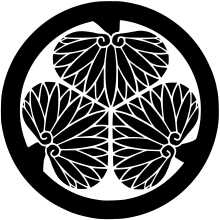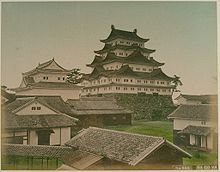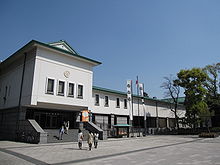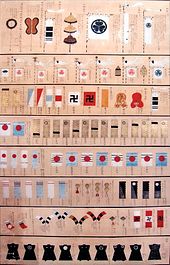- Owari branch
-
 Maruni-mitsubaaoi ("Circle Around Three Hollyhock Leaves"), the Tokugawa clan Owari branch mon (crest).
Maruni-mitsubaaoi ("Circle Around Three Hollyhock Leaves"), the Tokugawa clan Owari branch mon (crest).
The Owari (徳川尾張家 Tokugawa Owari-ke) branch of the Tokugawa clan is descended from Tokugawa Yoshinao, the ninth son of Tokugawa Ieyasu. It is also the main Gosanke ("three honourable houses of the Tokugawa").[1] For over 250 years, the Owari family ruled Owari Domain, the area surrounding present day Nagoya, Aichi Prefecture, using Nagoya Castle as its main base.[2] Another residence was the Ōzone Shimoyashiki.
The treasures of the Owari branch are kept in the Tokugawa Art Museum in Nagoya.
The present head of the family is Tokugawa Yoshitaka.
Heads
- Tokugawa Yoshinao (1601–1650)
- Tokugawa Mitsutomo (1625–1700)
- Tokugawa Tsunanari (1652–1699)
- Tokugawa Yoshimichi (1689–1713)
- Tokugawa Gorōta (1711–1713)
- Tokugawa Tsugutomo (1692–1731)
- Tokugawa Muneharu (1696–1764)
- Tokugawa Munekatsu (1705–1761)
- Tokugawa Munechika (1733–1800)
- Tokugawa Naritomo (1793–1850)
- Tokugawa Nariharu (1819–1839)
- Tokugawa Naritaka (1810–1845)
- Tokugawa Yoshitsugu (1836–1849)
- Tokugawa Yoshikatsu (1824–1883)
- Tokugawa Mochinaga (1831–1884)
- Tokugawa Yoshinori (1858–1875)
- Tokugawa Yoshikatsu (1824–1883)
- Tokugawa Yoshiakira(1863-1908)
- Tokugawa Yoshichika(1886-1976)
- Tokugawa Yoshitomu(1911-1992)
- Tokugawa Yoshinobu (1933-2005)
- Tokugawa Yoshitaka (born 1961)
Ranks of the Owari branch
The number of retainers of the Owari branch stood at around six to seven thousand, although it varied with each era. The guaranteed stipend that retainers would receive from the clan for their personnel (personal servants of samurai, etc.) was specified in provisions for mobilisation during military service. For the Owari clan, these provisions for mobilisation during military service were established in Kan'ei 10 (1633), and revised in Kanbun 1 (1661) and Kansei 6 (1794). The essence of these revisions was to vary the number in the established ranks. Horses, etc. were also required on the battlefield, and the number of these in the retainer's stipend was also guaranteed in the provisions.
References
- ^ Hosa Library, City of Nagoya. Hosa Library. Accessed July 4, 2007.
- ^ Nagoya Castle. Urabe Research Laboratory. Accessed July 4, 2007.
Categories:
Wikimedia Foundation. 2010.



